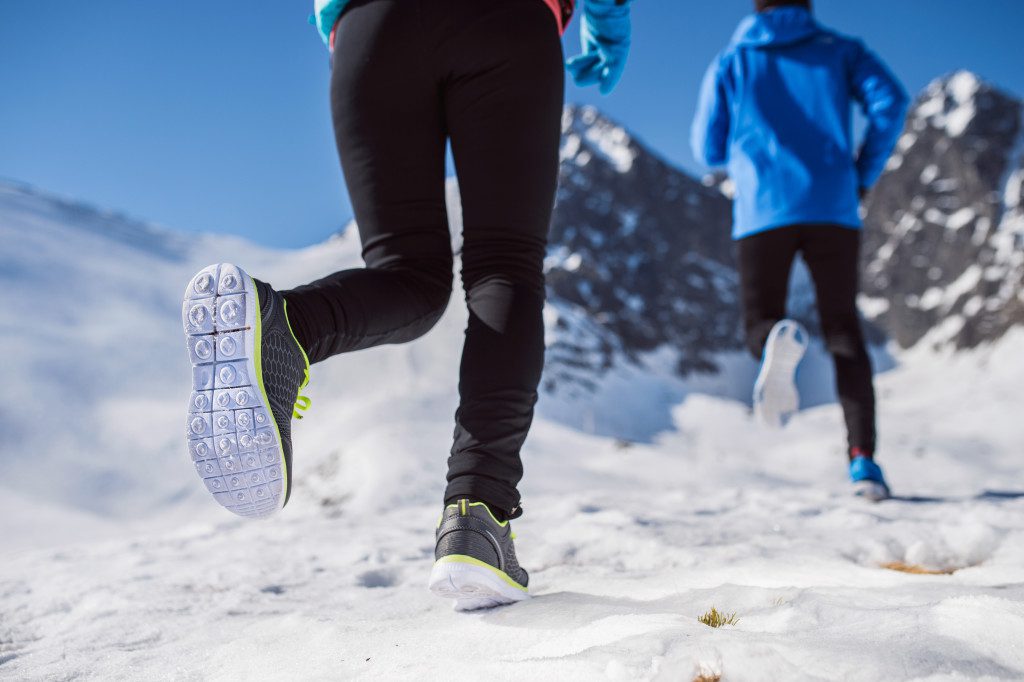Throwback Thursday: Roy Stevenson’s Tips for Cool Weather Running

The long, hot summer days are behind us now and the overcast skies are harbingers of the short, cold winter days to come. So, it’s time for a refresher on how to run in the cold. Winter running brings its own set of hazards—some of them potentially lethal—so you still need to adopt a safety mindset when running outdoors in those dark nights.
Many runners regard the dark, rainy winter days as an excuse to take it easy, which means they have to regain their previous hard-earned fitness the following spring. Instead, the winter months should be seen as a time to put in as much conditioning work as you can comfortably handle, so that you’ll be your fittest ever next racing season.
Weathering the Cold
You’ll be running slower than normal due to the poor traction on snow and ice, the wind, low visibility, and wearing several layers of clothing. Once you accept this you won’t be tempted to try to maintain your normal faster summer pace in dangerous winter conditions. Trying to maintain a fast pace often results in disaster—falling on ice or slippery roads causes abrasions, bruises, broken bones and muscle strains which can put you out of running for weeks—so settle back into your steady winter pace and enjoy it. And watch the terrain closely. Walk around icy patches and be careful while running downhill and around corners. If you find yourself on slippery terrain slow down to a shuffle, shorten your stride, and run flat-footed for more shoe contact with the ground. Stay relaxed and keep your balance.
Several myths still prevail about running in the cold, especially the belief that running will provide the necessary heat to keep you warm in cold temperatures. Given the combination of low body fat on distance runners, extreme cold, and sweat accumulating in your clothing, heat loss often exceeds heat production during long runs and you runner can easily become hypothermic.
Another prevailing myth is that lung tissue will freeze in sub-zero temperatures with the rapid, deep breathing of cold air. Research by McFadden (1984) found that cold air poses no danger of damaging our respiratory passages. Even in extreme cold, incoming air warms to between 26 degrees to 32 degrees by the time it has reached the bronchi. But the downside to exercising in cold air is that during the warming process, the humidification of cold air causes a lot of water and heat loss from the respiratory tract (mouth, trachea, larynx, bronchi). This moisture and heat loss causes a dry mouth, burning throat, irritation of the respiratory passages, and dehydration that can lead to throat infections. Therefore, drink frequently drinks to keep your throat moist and to rehydrate after running.
The Chilling Wind
It’s not the actual temperature that causes hypothermia—it’s the combination of temperature and wind speed. Cold wind displaces the insulating warm air that surrounds our body while we run, causing an overall heat loss through convection. For example, running in a calm 30 degrees can seem quite warm, but running in that same temperature with a wind gusting at 20 miles per hour will bring the effective wind chill temperature down to -15 degrees, making it dangerous to run.
It’s a good idea, on cold, windy days, to run out-and-back courses: head into the wind on your way out, and return with the wind at your back. If you do it the other way around, your sweat will freeze on your body, making you a potential victim to hypothermia.
Winter Running Clothing—What to Wear
Most winter running clothes are made from microfiber these days, which are almost as waterproof as Goretex. Because water conducts heat away from our body 26 times faster than air, you should stay as dry as possible while running. Microfiber carries water and heat away from the body surface, making it ideal in most moderate winter climates. Admittedly, Goretex is waterproof and snowproof, but in moderate climates it causes overheating. In most winter running conditions, wearing waterproof clothing isn’t as important as having breathable clothing; so most runners choose microfiber gear. Thus, you probably only need Goretex gear if you run in heavy snow and extreme cold.
The key to successful cold weather running is to wear your clothing in layers—the layers of clothing trap air between them and the air warms up from body heat. And if you start overheating, you can always increase the airflow to your chest by unzipping your jacket.
Cover Your Head
You can lose up to 40 percent of your total body heat from your noggin, so on wet, cold, or windy days, a woolen hat or ski mask should be worn. The ideal material for these is microfiber or wool.
Hands and Fingers
Your hands and fingers only have a small blood supply, so protect them with microfiber (or wool) gloves, mittens, or woolen socks. Mittens are warmer than gloves because they keep your fingers together, so their combined heat keeps your hands warmer. Woolen or polypropylene socks are also fine for your feet for winter running.
Your Legs
Wear tights when it is below 40 degrees F. Microfiber/polypropylene tights are suitable for cooler weather 40°F and above, while polypropylene tights are for much colder weather.
Bear in mind that the following are only “rule-of-thumb” guidelines, and that different people have different cold thresholds.
Running Safely in the Winter
Be wary of sliding or out-of-control cars on icy or snowy roads. You can’t respond as quickly on a slippery surface, and need to be very defensive.
Wear dark clothing to contrast against snow in the daytime and light-colored clothing at night. Wear a large runner’s reflective vest when running at night, dawn, or dusk. Anything you can wear that will make you more visible when you run will improve your safety.
Reflective safety items include headlamps, leg bands, armbands, hot spots, safety lights, illuminated hats and caps, etc. There are many different brands of reflective vests and apparel. A relatively new development in reflective vest technology is the Light Emitting Diode (LED) flashing lights and vests, with 500 candlepower reflectivity that can be seen from 1,200 feet away.
Caution: despite all this high tech reflective gear, with fog and rain, drivers will still NOT be able to see you—so never assume that wearing reflective clothing will guarantee your visibility to an oncoming driver.
Include one day per week of interval training in your winter conditioning, because one quick interval workout each week keeps your neuromuscular system and fast twitch muscle fibers revved up so you’ll never lose that important leg speed and strength, and keep your lactate threshold up to par.
Winter running brings its own set of difficulties that must be planned for. Depending on the climate in your area, you will need to dress accordingly, in layers if necessary. Cold conditions should not cause you to stop training; it’s more a matter of planning accordingly. But when all else fails, and the temperature has dipped below zero, think about taking a day off or going indoors to use a treadmill, or other cross-training equipment.
References
McFadden E. 1984. Respiratory heat and water exchange: physiological and clinical implications. European Journal of Applied Physiology. 54:331
Freelance writer Roy Stevenson, has over 200 articles on running, triathlons, sports, fitness and health published in over sixty regional, national and international magazines in the U.S.A, Canada, England, Scotland, Ireland, South Africa, Australia and New Zealand. To view more of Roy Stevenson’s running articles go to www.Roy-Stevenson.com


